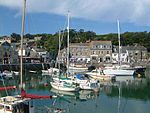Padstow railway station (England)
Beeching closures in EnglandDisused railway stations in CornwallFormer London and South Western Railway stationsPadstowPages with no open date in Infobox station ... and 3 more
Railway stations in Great Britain closed in 1967Railway stations in Great Britain opened in 1899Use British English from July 2014

Padstow railway station (Cornish: Lannwedhenek) was the western terminus of the North Cornwall Railway. It was opened in 1899 by the London and South Western Railway (LSWR) to serve the port of Padstow. It closed in 1967 having been proposed for closure in the Beeching Report.
Excerpt from the Wikipedia article Padstow railway station (England) (License: CC BY-SA 3.0, Authors, Images).Padstow railway station (England)
Riverside,
Geographical coordinates (GPS) Address Nearby Places Show on map
Geographical coordinates (GPS)
| Latitude | Longitude |
|---|---|
| N 50.538738 ° | E -4.936037 ° |
Address
Riverside
PL28 8BY
England, United Kingdom
Open on Google Maps











